Final Exam Review PDF

| Title | Final Exam Review |
|---|---|
| Course | Biosciences II |
| Institution | The University of Texas at San Antonio |
| Pages | 48 |
| File Size | 3.7 MB |
| File Type | |
| Total Downloads | 102 |
| Total Views | 172 |
Summary
review...
Description
FINAL EXAM REVIEW. Chapter 1: Define Biology, the Scientific Method, and Life. Define Biology & be able to list its hierarchy of organization (moleculesbiosphere). Science: Knowledge that covers general truths or the operation of general laws regarding the nature of the universe, especially when acquired and tested by the scientific method Biology: The study of living organisms and their interactions with one another and their environments. Biology is a Natural Science/Life Science • Natural Sciences can be divided into: • Life Sciences (e.g. Biological sciences) • Physical Sciences (e.g. Physics & Chemistry) • Earth & Space Science (e.g. Astronomy, Geology). Biology Can Be Both Basic or Applied.
Describe the Scientific Method (i.e. what steps are involved?)
D\fine hypothesis and theory. What is the difference between the two?
1
• Hypothesis: A suggested explanation for an event, which one can TEST. Can you “PROVE” a hypothesis? • NO!! NO!!! NO!! • Any hypothesis must be testable & falsifiable (they can be disproved). • You can NEVER prove a hypothesis. So what do we say if your hypothesis is supported? YOU “FAIL TO REJECT” A HYPOTHESIS! • Theory: A tested and confirmed explanation for observations or phenomena. Note: A hypothesis may become a verified theory What are the 9 properties of life? Give examples.
2
Know the basic structure of the tree of life (i.e. 3 domains, kingdoms).
Chapter 2: What are the building blocks of life? Define atoms, elements, molecules, and matter. What are they and how do they relate to one another? MATTER: Any substance that occupies space and has mass. An element is a substance that cannot be broken down chemically into any other substances. An atom is a bit of matter that cannot be subdivided any further without losing its essential properties. Molecules are groups of atoms held together by bonds What are the parts of an atom? Protons? Neutrons? Electrons? What is their charge? How much mass do they have? • Proton: + charged • Neutron: Uncharged • Electron: negatively charged; Electron Mass = 1/1800 amu ATOMIC MASS CALCULATED BASED UPON PROTONS AND NEUTRONS. Protons and neutrons have the same mass: 1 atomic mass unit (amu) or one Dalton.
3
How are elements arranged in the periodic table (rows vs. columns)? Define and be able to calculate: Atomic number, Mass number, and Atomic Mass. Where do you find these on the periodic table?
Groups(columns) are vertical and rows are horizontal valence electrons are represented by column number and orbital ring number represented by rows What is an isotope? What are some ways that biologists use isotopes?
How are electrons distributed around the nucleus of an atom? (Be familiar with the Bohr model and valence shells.) How many electrons can be placed in the first 3 electron shells? What is the octet rule? • Electron number and location determine reactivity. • Octet rule: Atoms with FULL valence shells are the most stable energetically. • Electron Orbital: Area where an electron is most likely to be found Electrons don’t orbit the nucleus like the sun. They are most likely to be found in specific locations. • Inert or Noble gases: Full Valence Shells 4
Describe how the three chemical bonds we discussed in class (ionic, covalent (polar and non-polar), and hydrogen) come about. Which are stronger?
5
Water: How do the chemical properties of water make life possible?
6
7
What is the pH scale? Where do acids and bases fall on this scale?
Acids: pH lower than 7.0 Acids have a higher concentration of H+ than OH− Can donate H+ to other chemicals H+ very reactive Corrode metals Stomach acids, vinegar, cola Bases: pH higher than 7.0 Bases have a higher concentration of OH− than H+ Taste bitter or have a slippery/soapy feel Neutralize acids by binding H+ to OH− Antacids Baking soda, bleach, milk of magnesia What are the properties of Carbon that make it an important building block of life?
What are functional groups and why are they important?
8
Chapter 3: Compare and Contrast the four major biological macromolecules and how they are built/broken down. What is a biological macromolecule? What are the four types of biological macromolecules we discussed? • Macromolecules are built from many smaller molecules. • Our food is made up of organic macromolecules: carbohydrates lipids proteins nucleic acids How are most biological macromolecules synthesized/broken down (i.e. dehydration, hydrolysis)? Dehydration synthesis, look at first picture on next question What are the characteristics of dehydration synthesis vs. hydrolysis (with respect to bond formation/dissolution, requiring/releasing energy, or releasing/requiring water).
Carbohydrates: What are some of the functions of carbohydrates? Examples? What is the basic molecular structure of a carbohydrate (e.g. (CH20)n). What is the difference between a monosaccharide, disaccharide, polysaccharide? Carbohydrates: starches, Grains, Fruits, and Vegetables are all natural carbohydrate sources, • Fuel & Building Material Carbohydrates are the primary fuel for cells. They form the structure of cells in all organisms. All carbs have the ratio: CH2O Glucose, the best known carb, has the formula: C6H12O6
9
Carbohydrates are composed of monosaccharides. Monosaccharides = simple sugars C−H bonds store large amounts of energy, ex: glucose, galactose, fructose. • Monosaccharides exist in linear and ring forms • In aqueous solutions, they are usually in ring forms. Disaccharides • Two monosaccharides combine (e.g. dehydration reaction). Disaccharides are made of two monosaccharides • Example: lactose (e.g. in milk); sucrose (e.g. table sugar Polysaccharides are made of 3 or more monosaccharides Starch consists of linked glucose molecules Breaking the chemical bonds in polysaccharides creates energy. What are lipids? How are they classified (e.g. steroid, wax, etc.)? Where do you encounter them in daily life? What are the functions of lipids? Lipid Functions • Store energy for long-term use • Provide insulation from the environment • Building blocks of hormones • Important constituent of cell membranes Lipids are hydrophobic molecules primarily comprised of C, H, & O. Contain mostly nonpolar C-C or C-H bonds. Contain significantly more C–H bonds than carbohydrates – more stored energy Insoluble in water Hydrophobic (not Hydrophilic) Molecules • Fat molecules contain much more stored energy than carbohydrate molecules! – The breakdown of fat molecules release ~2 times as much energy as the breakdown of carbohydrates Glycerol: hydrophilic “head” region Fatty acid: hydrophobic “tails” Triglycerides have three fatty acid tails. Fats Oils What is the difference between saturated and unsaturated fatty acids? Be able to recognize one or the other.
Phospholipids: What are these? How are they structured (i.e. glycerol, two fatty acid chains and a phosphate group). Identify the hydrophilic head and hydrophobic tail. Where do we find phospholipids? Define phospholipid bilayer and amphipathic. Glycerol: hydrophilic “head” region Fatty acid: hydrophobic “tails” Triglycerides have three fatty acid tails. Fats Oils Phospholipids are the major component of the cell membrane. They differ from fats in that they have only two fatty acid chains and a phosphorous atom in the glycerol “head” region
10
Proteins: What are the 8 different types of proteins? Give examples.
How are proteins structured? What is an amino acid (i.e. central C, amino group, carboxyl group, and R-side chain)? An amino acid polymer? A polypeptide? How is a protein more than just a polypeptide? Structure of Proteins • Proteins are Amino Acid Polymers • Amino Acids: Central C, bonded to an amino group (NH2), a carboxyl group (COOH), a hydrogen atom, and another atom or group of atoms (R-group), structure determines function Protein Synthesis • Dehydration reaction forming peptide bond • Polypeptides are unbranched polymers built from the same set of 20 amino acids • A protein is a biologically functional molecule that consists of one or more polypeptides Protein vs. Polypeptide • The sequence of amino acids, determined genetically, leads to a protein’s three-dimensional structure • A protein’s structure determines its function Proteins are an essential dietary component that play many roles in your health. Growth Repair Replacement Energy storage in bonds Each different protein has a different composition of amino acids. Some amino acids must be obtained from our diet – essential amino acids.
11
Know that there are 20 amino acids used to make proteins and that the side chains determine the proteins chemical properties. (No, you do not have to memorize all 20 of these amino acids).\ Listed above in chart Nucleic Acids: What are the two types of nucleic acids? • Deoxyribonucleic acid (DNA) • Ribonucleic acid (RNA) • Both play central roles in directing the production of proteins. How are nucleic acids structured? What is a polynucleotide? What is a nucleotide? How are nucleotides structured (i.e. pentose sugar, one or more phosphate groups, nitrogenous base).
12
Nucleic Acid Structure • Nucleic Acids are polymers of nucleotides (“polynucleotides”) • Each nucleotide consists of a nitrogenous base, a pentose sugar (deoxyribose or ribose), and one or more phosphate groups What are the 5 nitrogenous bases? Which are in RNA vs. DNA? Which pair together? Which are pyrimidines vs. purines? DNA • Has a double-helix structure. • Only certain types of base pairing are allowed (A-T and G-C) • Strands run antiparallel to one another (5’ to 3’ and 3’ to 5’) RNA • Single-stranded • Ribose sugar • Uracil, NO THYMINE • Ribonucleotide = ribose sugar, phosphate group, and one of four nitrogenous bases (A , U, G , C) Roles of DNA & RNA • DNA provides directions for its own replication • DNA directs synthesis of messenger RNA (mRNA) and, through mRNA, controls protein synthesis Pyrimidines: Thymine, Cytosine, Uracil Purines: Adenine, Guanine • Transcription: DNA dictates structure of RNA. • Translation: RNA dictates structure of protein Four Types of RNA • Messenger RNA (mRNA) • Ribosomal RNA (rRNA) • Transfer RNA (tRNA) • microRNA (miRNA) • A ribosome has two parts: a large subunit and a small subunit. The mRNA sits in between the two subunits. A tRNA molecule recognizes a codon (a sequence of 3 bases) on the mRNA, binds to it by complementary base pairing, and adds the correct amino acid to the growing peptide chain
13
Chapter 4. Know the major components of prokaryotic and eukaryotic cells and be able to tell how prokaryotic and eukaryotic cells are different. What are the differences between a Prokaryotic versus Eukaryotic cell? 1. A eukaryotic cell • has a central control structure called a nucleus that contains the cell’s DNA. • has membrane-bound organelles • Only some eukaryotic cells have cell walls. • Example Eukaryotes: Animals, Plants, Fungi, Protists 2. A prokaryotic cell • does not have a nucleus; its DNA simply resides in the middle of the cell. • does not have membrane-bound organelles. • Prokaryotes: Bacteria & Archaea
14
Be able to identify on a diagram of the cell and know the function of: the nucleus (with sub-parts), Golgi apparatus, endoplasmic reticulum (smooth and rough), chloroplast, mitochondria, lysosomes, centrosome, centriole, flagella, cilia.
15
What are some major differences between plant and animal cells? Pay particular attention to the central vacuole, cell walls, chloroplasts, and centrosomes. 16
look above
What is the function of the Extracellular Matrix (ECM) and what is it made of? (i.e. glycoproteins such as collagen, proteoglycans, and fibronectin). (network of proteins and carbs with the most abundant being collagen, holds cells together to form tissue and allows cells within the tissues to communicate with eachother) Plants have cell walls that provide additional protection and support for plant cells. • Plasmodesmata are tube-like channels that connect plant cells to each other and allows for transport of material. • Animal cells lack cell walls but are covered by an elaborate extracellular matrix (ECM) • The ECM is made up of glycoproteins such as collagen, proteoglycans, and fibronectin • Holds cells together to form a tissue and allows cells within the tissue to communicate with each other. What is the difference between plasmodesmata, gap junctions, desmosomes, and tight junctions? • Neighboring cells in an animal or plant often adhere, interact, and communicate through direct physical contact • There are several types of intercellular junctions that facilitate this • Plasmodesmata (Plants) • Tight junctions (Animal) • Desmosomes (Animal) • Gap junctions (Animal)
17
Chapter 5. Be able to describe the structure and function of the plasma membrane, as well as the methods by which substances cross it. What is/are the function(s) of the plasma membrane? What is meant by selective permeability? What are the 4 major membrane components?
What is a glycoprotein? A glycolipid? The glycocalyx? What is the function of the glycocalyx? Explain the Fluid Mosaic Model. ● Glycoprotein: protein with carbohydrate attached ● Glycolipid: lipid with carbohydrate attached
18
What types of molecules can cross the phospholipid bilayer easily? (hydrophobic vs. hydrophilic; non-polar vs. polar)?
What are transport proteins? How are carrier proteins different from channel proteins?
What is passive transport? Does it require energy? Passive Transport • Passive transport is diffusion of a substance across a membrane with NO energy investment • Diffusion is the tendency for molecules to spread out evenly into the available space What is diffusion? What is osmosis? How are the two different? • Diffusion is the tendency for molecules to spread out evenly into the available space.• Although each molecule moves randomly, diffusion of a population of molecules may be directional • At dynamic equilibrium, as many molecules cross the membrane in one direction as in the other • Osmosis is the diffusion of free water across a selectively permeable membrane • Water diffuses across a membrane from the region of lower solute concentration to the region of higher solute concentration until the solute concentration is equal on both sides
19
What factors impact diffusion? How? (Hint: extent of concentration gradient, mass of molecules, Temperature, solvent density, solubility, plasma membrane surface area, plasma membrane thickness, distance traveled.) What is dynamic equilibrium? ● At a dynamic equilibrium, as many molecules cross the membrane in one direction as in the other
What is the difference between active transport, passive transport, and bulk transport? • Passive transport is diffusion of a substance across a membrane with no energy investment • Active transport uses energy to move solutes against their gradients • Some transport proteins, however, can move solutes against their concentration gradients • Active transport allows cells to maintain concentration gradients that differ from their surroundings. • Primary active transport moves ions across a membrane and creates a difference in charge across that membrane; It is directly dependent on ATP • Secondary active transport (Co-Transport) is the movement of material due to the electrochemical gradient established by primary active transport • Bulk transport across the plasma membrane occurs by exocytosis and endocytosis • Solutes and water enter or leave the cell through the lipid bilayer or by means of transport proteins • Large molecules, such as polysaccharides and proteins, cross the membrane in bulk by means of vesicles • Bulk transport requires energy (it is a form of ‘active’ transport)• In exocytosis, transport vesicles migrate to the membrane, fuse with it, and release their contents to the cells exterior • Many secretory cells use exocytosis to export products• In endocytosis, the cell takes in molecules and particulate matter by forming new vesicles from the plasma membrane • Endocytosis is a reversal of exocytosis, involving different proteins • There are three types of endocytosis • Phagocytosis (“cellular eating”) • Pinocytosis (“cellular drinking”) • Receptor-mediated endocytosis (triggered by a key(receptor) that needs a lock that has to bind to a particular type of molecule) What is the sodium-potassium pump? How does it work? What is moved into/out of the cell? (potassium IN/ Sodium OUT) At what ratio? (3NA: 2 K ions)
20
Chapter 6. Describe how energy is transformed in exergonic and endergonic reactions. Exergonic releases free energy, it is spontaneous and goes from high to low Endergonic absorbs free energy, nonspontaneous and low to high Define metabolism and metabolic pathway. What do we call the compounds we start with and end with? What catalyzes the steps in between? What is meant by catalyze? • Metabolism is the totality of an organism’s chemical reactions • Metabolism is an emergent property of life that arises from interactions between molecules within the cell • Bioenergetics is the study of how organisms manage their energy resources • A metabolic pathway begins with a specific molecule and ends with a product • Each step is catalyzed by a specific enzyme
What is a catabolic pathway? An anabolic pathway? • Catabolic pathways release energy by breaking down complex molecules into simpler compounds • Cellular respiration, the breakdown of glucose in the presence of oxygen, is an example of a pathway of catabolism • Anabolic pathways consume energy to build complex molecules from simpler ones • The synthesis of protein from amino acids is an example of anabolism
21
What is the first law of thermodynamics/the principle of conservation of energy? Thermodynamics is the study of the transformation of energy from one type to another. First Law of Thermodynamics – energy can never be created or destroyed; it can only be transformed or transferred. The first law of thermodynamics is also called the principle of conservation of energy What is the second law of thermodynamics? Second Law of Thermodynamics – every conversion of energy is not perfectly efficient; some energy will be converted to heat • During every energy transfer or transformation, some energy is unusable and is often lost as heat • According to the second law of thermodynamics • Every energy transfer or transformation increases the entropy of the universe What is a spontaneous process? Do they increase or decrease the entropy of the universe?
• Cells create ordered structures from less ordered materials • Organisms also replace ordered forms of matter and energy with less ordered forms • The evolution of more complex organisms does not violate the second law of thermodynamics • Entropy (disorder) may decrease in an organism, but the universe’s total entropy increases • Organisms are islands of low entropy in an increasingly random universe • Thermodynamics is the study of energy transformations • An isolated system, such as that approximated by liquid in a thermos, is isolated from its surroundings • In an open system, energy and matter can be transferred between the system and its surroundings • Organisms are open systems • Reactions in a closed system eventually reach equilibrium and then do no work. • Cells are not in equilibrium; they are open systems experiencing a constant flow of materials • A defining feature of life is that metabolism is never at equilibrium What is the difference between an exergonic and an endergonic reaction? Which is spontaneous? Is ∆G positive or negative for each of these? • A living system’s free energy is energy that can do work when temperature and pressure are uniform, as in a living cell • Biologists want to know which reactions occur spontaneously ...
Similar Free PDFs

Chem Final Exam Review
- 12 Pages

Final Exam - Review notes
- 92 Pages

Bio Final Exam Review
- 2 Pages

Final EXAM Review booklet
- 5 Pages
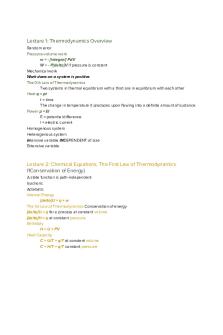
CHEM303 final exam review
- 4 Pages

Psychology Final Exam - Review
- 13 Pages
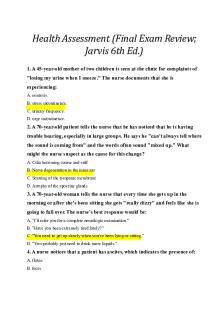
Jarvis Final Exam Review
- 12 Pages
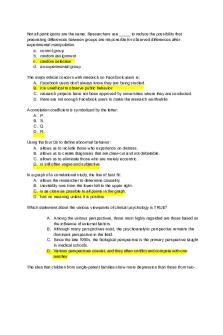
Final exam review
- 96 Pages
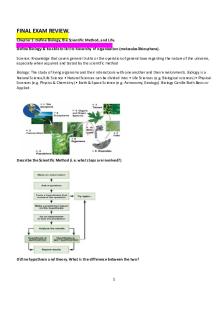
Final Exam Review
- 48 Pages
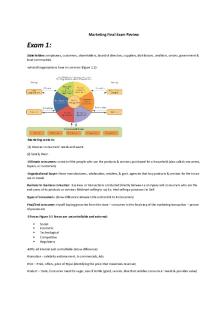
Marketing Final Exam Review
- 15 Pages
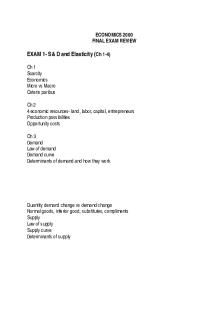
Final exam review
- 8 Pages
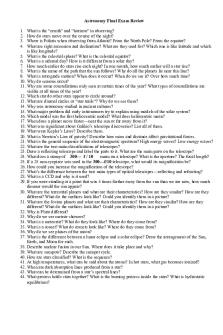
Astronomy Final Exam Review
- 2 Pages
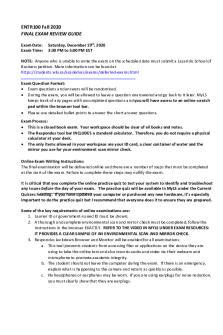
Final Exam Review Guide
- 4 Pages

Final exam review flsp4420
- 5 Pages

Theo Final Exam Review
- 16 Pages

Entrepreneurship final exam review
- 33 Pages
Popular Institutions
- Tinajero National High School - Annex
- Politeknik Caltex Riau
- Yokohama City University
- SGT University
- University of Al-Qadisiyah
- Divine Word College of Vigan
- Techniek College Rotterdam
- Universidade de Santiago
- Universiti Teknologi MARA Cawangan Johor Kampus Pasir Gudang
- Poltekkes Kemenkes Yogyakarta
- Baguio City National High School
- Colegio san marcos
- preparatoria uno
- Centro de Bachillerato Tecnológico Industrial y de Servicios No. 107
- Dalian Maritime University
- Quang Trung Secondary School
- Colegio Tecnológico en Informática
- Corporación Regional de Educación Superior
- Grupo CEDVA
- Dar Al Uloom University
- Centro de Estudios Preuniversitarios de la Universidad Nacional de Ingeniería
- 上智大学
- Aakash International School, Nuna Majara
- San Felipe Neri Catholic School
- Kang Chiao International School - New Taipei City
- Misamis Occidental National High School
- Institución Educativa Escuela Normal Juan Ladrilleros
- Kolehiyo ng Pantukan
- Batanes State College
- Instituto Continental
- Sekolah Menengah Kejuruan Kesehatan Kaltara (Tarakan)
- Colegio de La Inmaculada Concepcion - Cebu